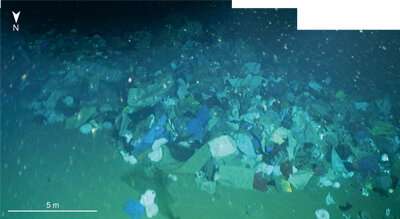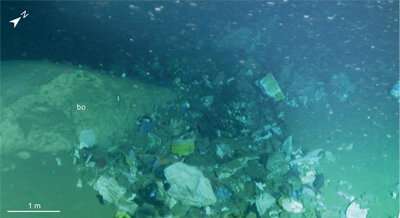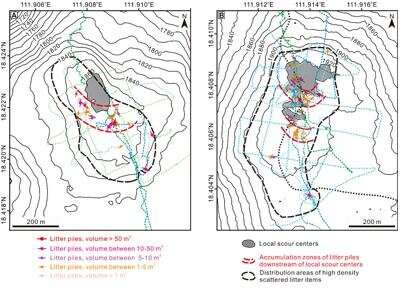Deep-sea plastic accumulations by turbidity currents: NW South China sea

Benthic plastic litter is a main source of pollutants in oceans, but how it disperses is largely unknown. This study by Guangfa Zhong and Xiaotong Peng, published today in Geology, presents novel findings on the distribution patterns and dispersion mechanisms of deep-sea plastic waste in a submarined canyon located in the northwestern South China Sea.
Evidence collected from a series of manned submersible dives indicate that the plastic litter items transported and deposited in the canyon are most likely controlled by turbidity currents. Here the plastic litter items are highly heterogeneously distributed: Up to 89% of them occur in a few scours of the canyon.
The plastic items are mostly accumulated in longitudinal litter piles of 2-61 m long, 0.5-8 m wide, and 0.1-1.2 m high on average. Plastic particles and fragments generally occurred on the upstream-facing sides of large boulders and other topographic obstacles, indicating obstruction during down-valley transportation. Furthermore, the litter piles were mostly distributed in the up-valley dipping slopes downstream of the scour centers, which is tentatively linked to the deceleration of turbidity currents after shedding down the steep upstream slopes of the scours and undergoing a hydraulic jump at the scour centers. This interpretation is supported by the sedimentological evidence from grain-size analysis of associated seabed sediment.
The results of this study lend support to the hypothesis of turbidity-current-controlled dispersion of plastic litter and bear implications on deep-sea environmental protection and surveillance. The focused and patterned distribution of benthic plastics in the canyon that can be reasonably explained by morphodynamic interactions sheds light on monitoring or even removal of deep-sea macro-plastic pollutants.
-

Photo showing plastic particles and fragments occurred on the upstream-facing side of a large boulder. Upstream is on the right side. A higher-resolution photo is available. Credit: Guangfa Zhong and Xiaotong Peng -

Bathymetric contour maps in the upper (A) and lower (B) scours at the downstream end of the steeper middle reach of the canyon, showing distribution of the plastic litter piles in the up-valley (northward) dipping slopes downstream of local scour centers. Color dotted lines indicate litter piles, with dots denoting locations and lines indicating orientations. Color dashed lines show dive tracks. Thin solid black lines represent isobaths. A higher-resolution version of this figure is available. Credit: Guangfa Zhong and Xiaotong Peng
More information: Guangfa Zhong et al. Transport and accumulation of plastic litter in submarine canyons—The role of gravity flows, Geology (2021). DOI: 10.1130/G48536.1
Journal information: Geology
Provided by Geological Society of America




















